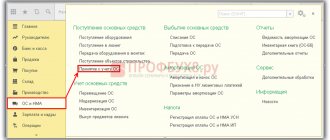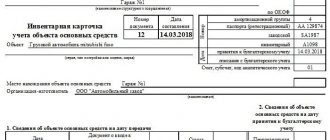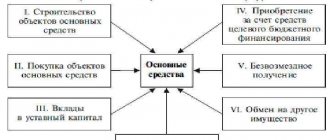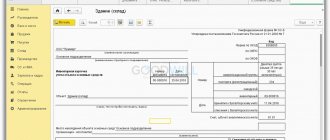Documenting
The decision to reconstruct fixed assets must be formalized by order of the head of the organization, which must indicate:
- reasons for reconstruction;
- timing of its implementation;
- persons responsible for the reconstruction.
This is explained by the fact that all operations must be documented (Article 9 of the Law of December 6, 2011 No. 402-FZ).
If an organization does not carry out reconstruction on its own, then a contract must be concluded with the contractors (Article 702 of the Civil Code of the Russian Federation).
When transferring the fixed asset to the contractor, issue an act of acceptance and transfer of the fixed asset for reconstruction. Since there is no unified form of the act, the organization can develop it independently. If the fixed asset is lost (damaged) by the contractor, the signed act will allow the organization to demand compensation for losses caused (Articles 714 and 15 of the Civil Code of the Russian Federation). In the absence of such an act, it will be difficult to prove the transfer of fixed assets to the contractor.
When transferring a fixed asset for reconstruction to a special division of the organization (for example, a repair service), an invoice for internal movement should be drawn up in form No. OS-2. If the location of the fixed asset does not change during reconstruction, no transfer documents need to be drawn up. This procedure follows from the instructions approved by Resolution of the State Statistics Committee of Russia dated January 21, 2003 No. 7.
Upon completion of the reconstruction, an acceptance certificate is drawn up in form No. OS-3. It is filled out regardless of whether the reconstruction was carried out economically or by contract. Only in the first case, the organization draws up the form in one copy, and in the second - in two (for itself and for contractors). The act is signed by:
- members of the acceptance committee created in the organization;
- employees responsible for the reconstruction of the fixed asset (or representatives of the contractor);
- employees responsible for the safety of fixed assets after reconstruction.
After this, the act is approved by the head of the organization and it is transferred to the accountant.
If the contractor carried out the reconstruction of a building, structure or premises, which relates to construction and installation work, then in addition to the act in form No. OS-3, an acceptance certificate in form No. KS-2 and a certificate of the cost of work performed and expenses in form No. must be signed. KS-3, approved by Resolution of the State Statistics Committee of Russia dated November 11, 1999 No. 100.
How is it different from upgrading the OS?
The concepts of “reconstruction” and “modernization” are closely related to each other, but have several differences.
In paragraph 2 of Art. 257 of the Tax Code of the Russian Federation states that modernization includes technological or service changes in OS objects (for example, equipment or buildings), increased loads and other consumer qualities.
Thanks to such work, fixed assets comply with new standards and meet modern requirements.
Unlike reconstruction, modernization cannot include the restoration of the previous functions and properties of objects.
Modernization is always the replacement of previous means of labor or their elements with more efficient and modern ones, which leads to improved production.
When carrying out modernization, it remains possible to further use the replaced components. In accounting, they are defined as low-value and are included in the warehouse.
Thus, modernization is a subtype or component of OS reconstruction.
Order of conduct
OS reconstruction consists of several stages:
- The head of the organization issues an order. It indicates the timing, responsible persons and reasons for the conduct.
- The organization creates a special commission that must inspect fixed assets. After this, the commission draws up a schedule according to which the work will be carried out and approves the estimate and other documentation.
- Reconstruction of the OS can be carried out on the organization's own resources and resources, or with the involvement of third parties. In the second case, you must first conclude an agreement with the contractor.
- All work carried out must be properly documented (conclude a contract, draw up work acceptance certificates, etc.) and draw up supporting documents (Article 9 of Federal Law No. 402 “On Accounting”).
- In accounting, existing documents are carefully analyzed and checked in order to recognize them as reconstruction. This is done to avoid disputes with the Federal Tax Service regarding expenses incurred.
- If, after the procedure, any characteristics of the fixed asset have changed, then state registration may be necessary.
Documenting
In the resolution of the State Statistics Committee of the Russian Federation dated January 21, 2003.
No. 7 “On approval of unified forms of primary accounting documentation for accounting of fixed assets” you can see a list of forms, as well as learn how to apply and fill out these primary documents. The forms given in the resolution are unified and are used for organizations of all forms of ownership on the territory of the Russian Federation.
The only exceptions are budgetary and credit institutions.
After drawing up the order and estimate, you need to transfer the OS for reconstruction. To do this, you can use the OS-2 form, since there is no special form in this case.
If the procedure is carried out by a third party, then the OS-1 form can be used.
To accept completed work, it is necessary to issue an act of form OS-3. This act must be signed by members of the commission or an authorized person and a representative of the department or company that carried out the reconstruction.
Then the act is approved by management and sent to the accounting department. If the work was carried out by a third-party organization, then a second copy of the report must be sent to it.
Form OS-3 describes the condition of the fixed asset before reconstruction and the costs of it.
Inventory cards contain information about each fixed asset. Form OS-6, section 5 should contain information on the actions taken.
Information on a group of OS objects is entered into Form OS-6a. Form OS-6b is used only in small enterprises.
If, after completing the work, the characteristics or purpose of the fixed asset item changes significantly, then it will be necessary to create a new inventory card.
Sample order
An order for reconstruction can be drawn up by the head of a unit, a lawyer, a secretary or another person close to the management of the organization.
There is no approved order template, but each organization has its own examples of such documents.
General rules to follow:
- the order must be drawn up in a single copy and recorded in the accounting journal;
- if the document does not indicate its validity period, then by default it will be 1 year from the date of signing;
- at the top of the document the following is indicated: name of the organization, number and title of the order, date of creation, address;
- in the middle part of the order it is written: the reason for the reconstruction, a link to the internal document of the organization or a legislative document, the requirement for the reconstruction of the OS object and its characteristics, deadlines, the current state of the OS object, the composition of the commission and their responsibilities, other responsible persons;
- at the bottom there must be the signature of the director and all listed persons.
order for OS reconstruction – word.
State registration of changes
As a result of reconstruction, the characteristics of the building (structure), which were originally indicated during its state registration, may change. For example, the total area or number of floors of a building has changed. In this case, the new characteristics of the building (structure) must be registered in the state register (clause 68 of the Rules, approved by order of the Ministry of Economic Development of Russia dated December 23, 2013 No. 765). In this case, the building (structure) is not re-registered, but only an entry is made in the register about changes in its characteristics.
To register changes to the territorial office of Rosreestr you need to submit:
- application for amendments to the state register of rights to real estate and transactions with it;
- documents confirming changes in the relevant information previously entered into the state register (for example, a certificate from the BTI);
- payment order for payment of state duty in the amount of 1000 rubles. (Subclause 27, Clause 1, Article 333.33 of the Tax Code of the Russian Federation).
This is stated in paragraphs 4 and 5.1.1 of the Regulations approved by Decree of the Government of the Russian Federation dated June 1, 2009 No. 457, Section IX of the Methodological Instructions approved by Order of the Ministry of Justice of Russia dated July 1, 2002 No. 184.
What it is?
In paragraph 2 of Art. 257 of the Tax Code of the Russian Federation provides a definition of OS reconstruction, according to which this process includes changes to the organization’s facilities, carried out to improve production and its technical and economic indicators, improve quality, as well as change the range of products.
Thus, reconstruction can include an increase or decrease in the number of floors in a building, its area, the creation of new engineering and technical systems, redevelopment of premises or restoration of the previous state.
Accounting
Costs for the reconstruction of fixed assets change (increase) their initial cost in accounting (clause 14 of PBU 6/01).
The organization is obliged to keep records of fixed assets according to the degree of their use:
- in operation;
- in stock (reserve);
- during reconstruction, etc.
This is stated in paragraph 20 of the Methodological Instructions, approved by order of the Ministry of Finance of Russia dated October 13, 2003 No. 91n.
Accounting for fixed assets by degree of use can be carried out with or without reflection in additional subaccounts to accounts 01 (03). Thus, during long-term reconstruction, it is advisable to account for fixed assets in a separate sub-account “Fixed assets for reconstruction”. This approach is consistent with paragraph 20 of the Methodological Instructions, approved by Order of the Ministry of Finance of Russia dated October 13, 2003 No. 91n.
Debit 01 (03) subaccount “Fixed assets for reconstruction” Credit 01 (03) subaccount “Fixed assets in operation”
– the fixed asset was transferred for reconstruction.
Upon completion of the reconstruction, make the wiring:
Debit 01 (03) subaccount “Fixed assets in operation” Credit 01 (03) subaccount “Fixed assets under reconstruction”
– adopted from the reconstruction of the main asset.
Accounting for reconstruction costs
Costs for the reconstruction of fixed assets are taken into account on account 08 “Investments in non-current assets” (clause 42 of the Methodological Instructions approved by Order of the Ministry of Finance of Russia dated October 13, 2003 No. 91n). To ensure the possibility of obtaining data on types of capital investments, it is advisable to open a sub-account “Reconstruction Expenses” for account 08.
The costs of carrying out the reconstruction of fixed assets using economic methods consist of:
- from the cost of consumables;
- from employee salaries, deductions from it, etc.
Reflect the costs of carrying out reconstruction on your own by posting:
Debit 08 subaccount “Reconstruction expenses” Credit 10 (16, 23, 68, 69, 70...)
– the costs of reconstruction are taken into account.
If an organization carries out the reconstruction of fixed assets with the involvement of a contractor, then reflect his remuneration by posting:
Debit 08 subaccount “Reconstruction expenses” Credit 60
– the costs of reconstruction of fixed assets carried out by contract are taken into account.
Upon completion of the reconstruction, the costs recorded on account 08 can be included in the initial cost of the fixed asset or taken into account separately on account 01 (03). This is stated in paragraph 2 of paragraph 42 of the Methodological Instructions, approved by order of the Ministry of Finance of Russia dated October 13, 2003 No. 91n.
When including reconstruction costs in the initial cost of a fixed asset, make the following entry:
Debit 01 (03) Credit 08 subaccount “Reconstruction expenses”
– the initial cost of the fixed asset was increased by the amount of reconstruction costs.
In this case, reflect the costs of reconstruction in the inventory card for accounting for fixed assets in form No. OS-6 (OS-6a) or in the inventory book in form No. OS-6b (used by small enterprises). This is stated in the instructions approved by the State Statistics Committee of Russia dated January 21, 2003 No. 7. If it is difficult to reflect information about the reconstruction carried out in the old card, open a new one instead (clause 40 of the Methodological instructions approved by order of the Ministry of Finance of Russia dated October 13, 2003 No. 91n).
When accounting separately, write off the costs of reconstruction to a separate subaccount to account 01 (03). For example, the subaccount “Expenses for the reconstruction of fixed assets”:
Debit 01 (03) subaccount “Expenses for the reconstruction of fixed assets” Credit 08 subaccount “Expenditures for reconstruction”
– costs for reconstruction of fixed assets are written off to account 01 (03).
In this case, for the amount of expenses incurred, open a separate inventory card in form No. OS-6. This is stated in paragraph 2 of paragraph 42 of the Methodological Instructions, approved by order of the Ministry of Finance of Russia dated October 13, 2003 No. 91n.
Features of tax accounting
When taxing OS there are some features:
- The funds that were spent on reconstruction ultimately increase the cost of the operating system, but will be written off as expenses using depreciation. Therefore, it is important to correctly qualify the work performed so as not to run into problems when accounting for expenses for profit tax purposes.
- According to the Tax Code of the Russian Federation, it is possible to extend the useful life of fixed assets (but not above the upper limit of the depreciation group limit) if, upon completion of reconstruction, the service life increases (clause 1 of Article 258 of the Tax Code of the Russian Federation).
- It is possible to qualify the work carried out as reconstruction for the purpose of calculating income tax only if there is a project.
- The organization is obliged to keep cumulative records of information about the costs of reconstruction against the background of other expenses.
- Once the process is completed, an estimate of the initial cost must be carried out. Expenses for reconstruction before putting the asset into operation are considered to form the initial cost of the asset.
Expenses for the reconstruction of the OS are taken into account for taxation from the 1st day of the month following the month of putting the OS object into operation.
Depreciation during reconstruction
When carrying out reconstruction with a period of no more than 12 months, calculate depreciation on the fixed asset. If the reconstruction of a fixed asset takes more than 12 months, then suspend depreciation on it. In this case, resume depreciation after the reconstruction is completed. This procedure is established in paragraph 23 of PBU 6/01 and paragraph 63 of the Methodological Instructions, approved by Order of the Ministry of Finance of Russia dated October 13, 2003 No. 91n.
Situation: at what point in accounting should you stop and then resume depreciation on a fixed asset transferred for reconstruction for a period of more than 12 months?
For accounting purposes, the specific moment of termination and resumption of depreciation on fixed assets transferred for reconstruction for a period of more than 12 months is not established by law. Therefore, the month from which the accrual of depreciation for accounting purposes for such fixed assets stops and resumes must be established independently by the organization.
In this case, possible options could be:
- depreciation is suspended from the 1st day of the month in which the fixed asset was transferred for reconstruction. And it resumes from the 1st day of the month in which the reconstruction was completed;
- depreciation is suspended from the 1st day of the month following the month in which the fixed asset was transferred for reconstruction. And it resumes from the 1st day of the month following the month in which the reconstruction was completed.
Fix the chosen option for suspending and resuming depreciation in the organization’s accounting policies for accounting purposes.
Advice: in your accounting policy for accounting purposes, establish the same procedure for stopping and resuming depreciation on fixed assets transferred for reconstruction for a period of more than 12 months, as in tax accounting.
In this case, temporary differences will not arise in the organization’s accounting, leading to the formation of a deferred tax liability.
Lifetime of OS after reconstruction
Reconstruction work can lead to an increase in the useful life of the fixed asset. In this case, for accounting purposes, the remaining useful life of the reconstructed fixed asset must be revised (clause 20 of PBU 6/01, clause 60 of the Methodological Instructions approved by Order of the Ministry of Finance of Russia dated October 13, 2003 No. 91n). This is what the acceptance committee does when accepting a fixed asset from reconstruction:
- based on the period during which it is planned to use the fixed asset after reconstruction for management needs, for the production of products (performance of work, provision of services) and other generation of income;
- based on the period after which the fixed asset is expected to be unsuitable for further use (i.e., physically worn out). This takes into account the mode (number of shifts) and negative operating conditions of the fixed asset, as well as the system (frequency) of repairs.
This procedure follows from paragraph 20 of PBU 6/01.
The acceptance committee must indicate in the report in form No. OS-3 that the reconstruction work did not lead to an increase in useful life.
The results of the review of the remaining useful life in connection with the reconstruction of a fixed asset must be formalized by order of the manager.
Situation: how to calculate depreciation in accounting after reconstruction of a fixed asset?
The procedure for calculating depreciation after the reconstruction of a fixed asset is not defined by accounting legislation. Paragraph 60 of the Methodological Instructions, approved by Order of the Ministry of Finance of Russia dated October 13, 2003 No. 91n, provides only an example of calculating depreciation charges using the linear method. So, according to the example, with the linear method, the annual amount of depreciation of fixed assets after reconstruction is determined in the following order.
Calculate the annual depreciation rate of fixed assets after reconstruction using the formula:
| Annual depreciation rate for fixed assets after reconstruction using the linear method | = | 1 | : | Useful life of a fixed asset after reconstruction, years | × | 100% |
Then calculate the annual depreciation amount. To do this, use the formula:
| Annual amount of depreciation of fixed assets after reconstruction using the linear method | = | Annual depreciation rate for fixed assets after reconstruction using the linear method | × | Residual value of fixed assets taking into account reconstruction costs |
The amount of depreciation that must be accrued monthly is 1/12 of the annual amount (paragraph 5, clause 19 of PBU 6/01).
If an organization uses other methods of calculating depreciation (the reducing balance method, the method of writing off value by the sum of the numbers of years of useful life, the method of writing off value in proportion to the volume of production (work)), then the annual amount of depreciation charges can be determined in the following order:
- similar to the order given in the example for the linear method;
- independently developed by the organization.
The used option for calculating depreciation on fixed assets after reconstruction should be fixed in the accounting policy of the organization for accounting purposes.
An example of reflecting depreciation on a fixed asset in accounting after its reconstruction
Alpha LLC repairs medical equipment. In April 2021, the organization reconstructed production equipment that was put into operation in July 2013.
The initial cost of the equipment is 300,000 rubles. The useful life according to accounting data is 10 years. The method of calculating depreciation is linear. As a result of the reconstruction, the useful life of the facility increased by 1 year.
Before the reconstruction of the fixed asset, the annual depreciation rate was 10 percent ((1: 10 years) × 100%).
The annual depreciation amount was 30,000 rubles. (RUB 300,000 × 10%).
The monthly depreciation amount was 2,500 rubles. (RUB 30,000: 12 months).
RUB 59,000 was spent on equipment reconstruction. The reconstruction lasted less than 12 months, so depreciation was not suspended. At the time of completion of the reconstruction, the actual service life of the equipment was 33 months. Its residual value according to accounting data is equal to: 300,000 rubles. – (33 months × 2500 rub./month) = 217,500 rub.
After reconstruction, the useful life of the fixed asset was increased by 1 year and amounted to 8.25 years (7.25 + 1). The annual depreciation rate for equipment after reconstruction was 12.1212 percent ((1: 8.25 years) × 100%).
The annual amount of depreciation is 33,515 rubles. ((RUB 217,500 + RUB 59,000) × 12.1212%).
The monthly depreciation amount is RUB 2,793. (RUB 33,515: 12 months).






